Input interpretation

1-amino-2-propanol
Chemical names and formulas
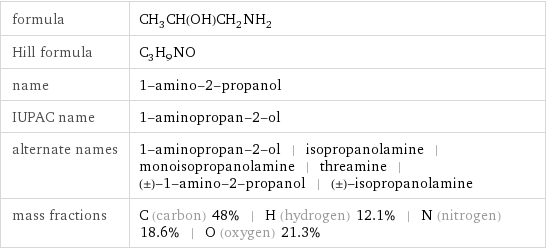
formula | CH_3CH(OH)CH_2NH_2 Hill formula | C_3H_9NO name | 1-amino-2-propanol IUPAC name | 1-aminopropan-2-ol alternate names | 1-aminopropan-2-ol | isopropanolamine | monoisopropanolamine | threamine | (±)-1-amino-2-propanol | (±)-isopropanolamine mass fractions | C (carbon) 48% | H (hydrogen) 12.1% | N (nitrogen) 18.6% | O (oxygen) 21.3%
Lewis structure
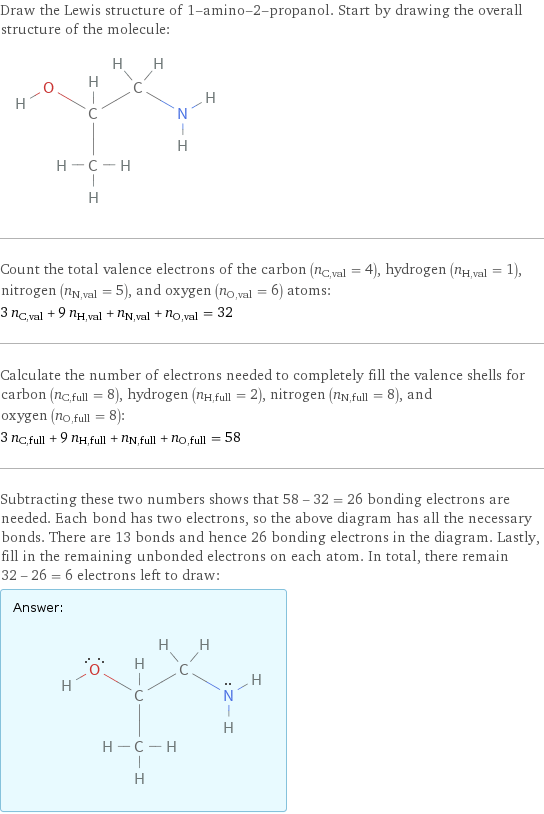
Draw the Lewis structure of 1-amino-2-propanol. Start by drawing the overall structure of the molecule: Count the total valence electrons of the carbon (n_C, val = 4), hydrogen (n_H, val = 1), nitrogen (n_N, val = 5), and oxygen (n_O, val = 6) atoms: 3 n_C, val + 9 n_H, val + n_N, val + n_O, val = 32 Calculate the number of electrons needed to completely fill the valence shells for carbon (n_C, full = 8), hydrogen (n_H, full = 2), nitrogen (n_N, full = 8), and oxygen (n_O, full = 8): 3 n_C, full + 9 n_H, full + n_N, full + n_O, full = 58 Subtracting these two numbers shows that 58 - 32 = 26 bonding electrons are needed. Each bond has two electrons, so the above diagram has all the necessary bonds. There are 13 bonds and hence 26 bonding electrons in the diagram. Lastly, fill in the remaining unbonded electrons on each atom. In total, there remain 32 - 26 = 6 electrons left to draw: Answer: | |
3D structure
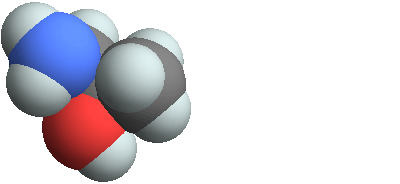
3D structure
Basic properties
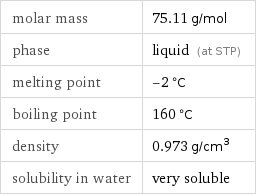
molar mass | 75.11 g/mol phase | liquid (at STP) melting point | -2 °C boiling point | 160 °C density | 0.973 g/cm^3 solubility in water | very soluble
Units

Hydrophobicity and permeability properties

experimental LogP hydrophobicity | -0.96 predicted LogP hydrophobicity | -2.74 predicted LogS | -0.05
Basic drug properties

approval status | experimental | small molecule
Liquid properties (at STP)
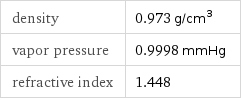
density | 0.973 g/cm^3 vapor pressure | 0.9998 mmHg refractive index | 1.448
Units

Thermodynamic properties
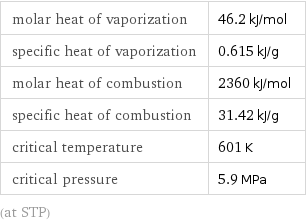
molar heat of vaporization | 46.2 kJ/mol specific heat of vaporization | 0.615 kJ/g molar heat of combustion | 2360 kJ/mol specific heat of combustion | 31.42 kJ/g critical temperature | 601 K critical pressure | 5.9 MPa (at STP)
Chemical identifiers
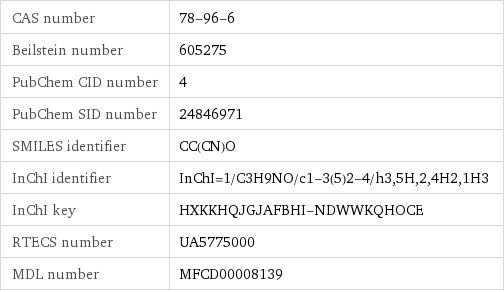
CAS number | 78-96-6 Beilstein number | 605275 PubChem CID number | 4 PubChem SID number | 24846971 SMILES identifier | CC(CN)O InChI identifier | InChI=1/C3H9NO/c1-3(5)2-4/h3, 5H, 2, 4H2, 1H3 InChI key | HXKKHQJGJAFBHI-NDWWKQHOCE RTECS number | UA5775000 MDL number | MFCD00008139
NFPA label

NFPA label

NFPA health rating | 2 NFPA fire rating | 2 NFPA reactivity rating | 0
Safety properties
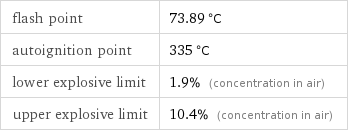
flash point | 73.89 °C autoignition point | 335 °C lower explosive limit | 1.9% (concentration in air) upper explosive limit | 10.4% (concentration in air)

DOT hazard class | 8 DOT numbers | 2735
Toxicity properties

RTECS classes | reproductive effector | primary irritant